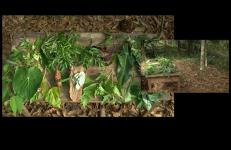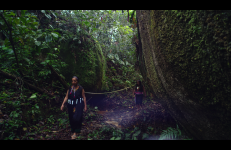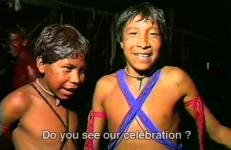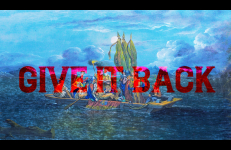Efforts to “decolonize” institutions are embodied in ritual acts of acknowledging Indigenous presence and claims to territory. However, without continuous commitment to serve as accomplices to Indigenous people, institutional gestures of acknowledgement risk reconciling “settler guilt and complicity” and rescuing “settler futurity” How can we escape this entrapment and allow acknowledgement to retain its potential to unsettle? What must we do to begin to undertake a process of endless acknowledgement?
Indigenous
Extractions parallels resource extraction with the booming child apprehension industry. As the filmmaker reviews how these industries have affected her, she reflects on having her own eggs retrieved and frozen to make an Indigenous baby.
Told through recollections of youth, learning, lore, and departure, this is an imagined myth for the Xąwįska — or the Indian Pipe Plant — used by the Ho-Chunk to revive those who have fainted.
Told through recollections of youth, learning, lore, and departure, this is an imagined myth for the Xąwįska — or the Indian Pipe Plant — used by the Ho-Chunk to revive those who have fainted.
This video is a three-channel synchronized composite and is available for educational use only. The three-channel version has the same main body of images as the single channel version, with the loops and the space in between the segments of content offering durational breaks that provide an alternative cyclical way of engaging with story and myth.
Frances, a young Gay Indian (2 Spirit), played by Lacey Hill, is struggling with the aftermath of a gay basing. Through her friendship with her ex Jean, she gathers the strength to go out in public again. This video is a salute to the 70s and to Gay Indian movements which became 2Spirit/Indigiqueer communities.
Song performed by Lacy Hill.
Forest Law underlines the persistent fact that we are yet to learn to live otherwise in an age defined by the colossal consequences of a new socio-geological order we ourselves have created through irresponsible interactions with Earth’s systems.
Forest Mind is a video work that emerges from the artist’s longstanding interest in the human interaction with the natural world. In a series of recent art projects, she has shed light on the cosmology of Indigenous communities and their political struggle to keep their forests alive.
Over 6,000 gold prospectors invade the reserve of the Nambiquara of Sararé, and loggers raid the mahogany-rich forests, which are threatened by extinction. Pressure on the World Bank (with whom the government of Mato Grosso is negotiating a loan) could end prospecting, but the pillage of the forest continues.
In Portuguese with English subtitles.
Directed by Vincent Carelli, Maurizio Longobardi, and Virginia Valadão; edited by Tutu Nunes.
Over 6,000 gold prospectors invade the reserve of the Nambiquara of Sararé, and loggers raid the mahogany-rich forests, which are threatened by extinction. Pressure on the World Bank (with whom the government of Mato Grosso is negotiating a loan) could end prospecting, but the pillage of the forest continues.
In Portuguese with English subtitles.
Directed by Vincent Carelli, Maurizio Longobardi, and Virginia Valadão; edited by Tutu Nunes.
Over 6,000 gold prospectors invade the reserve of the Nambiquara of Sararé, and loggers raid the mahogany-rich forests, which are threatened by extinction. Pressure on the World Bank (with whom the government of Mato Grosso is negotiating a loan) could end prospecting, but the pillage of the forest continues.
In Portuguese with English subtitles.
Directed by Vincent Carelli, Maurizio Longobardi, and Virginia Valadão; edited by Tutu Nunes.
Four Ikpeng children reply to a video-letter from the children of Sierra Maestra in Cuba, introducing their village, families, toys, celebrations, and ways of life with grace and lightheartedness. Curious to know about children from other cultures, they ask to continue the correspondence.
Direction and camera by Karané, Kumaré, and Natuyu Yuwipo Txicão; edited by Mari Corrê.
"i am very grateful that my 鬼鎮 (Ghosttown) series has shown internationally over the last couple years and is recognized by viewers, reviewers, critics, and curators as doing decolonizing work as a feminist project that queers and glitches the Western genre. 鬼鎮 (Ghosttown) questions the quintessentially American Western in the forms of experimental films and games that are made from glitches and noise, pushing boundaries of legibility and tipping over threshold states of stability.
Chief Pedro Mãmãindê (who directed the proceedings and the shoot itself) describes the necessity of strengthening the girls of his village by secluding them after their first menses. After several months, the village throws a party, with singing, feasting, and the ritual abduction of the girl by an allied village. When the Nambiquara of Mato Grosso see videotape of themselves performing this ritual, the excess of Western clothing makes them uncomfortable. The ritual is then re-enacted with traditional body painting and adornment.
Chief Pedro Mãmãindê (who directed the proceedings and the shoot itself) describes the necessity of strengthening the girls of his village by secluding them after their first menses. After several months, the village throws a party, with singing, feasting, and the ritual abduction of the girl by an allied village. When the Nambiquara of Mato Grosso see videotape of themselves performing this ritual, the excess of Western clothing makes them uncomfortable. The ritual is then re-enacted with traditional body painting and adornment.
Swerving between branded content, documentary, and a decolonial episode of MTV 'Cribs', the film revolves around a tour of an apartment which has supposedly been "given back" - led by reformed Native American impersonator, and frequent New Red Order collaborator, Jim Fletcher, alongside profiles of real individuals involved with the voluntary return of land to Indigenous peoples, organizations, and tribes. The film continues New Red Order's ongoing research into instances of settlers returning land to Indigenous peoples, a practice that has been growing exponentially over the past decade.
A conjuring and convocation to begin the chronomorphic process of ‘giving it back’.
Part of The Savage Philosophy of Endless Acknowledgment suite.
Give it Back: Stage Theory’s point of departure is the détournement of Panorama of the Monumental Grandeur of the Mississippi Valley (1850), a 9 foot tall, 348 foot long proto-cinematic moving panorama commissioned by and based on the contemporaneous notes and drawings of 19th century amateur archaeologist and glorified grave robber Montroville W. Dickeson — who spent 12 years of his life traveling the Mississippi River and digging up Indigenous burial mounds.
A psychedelic portrait exploring epistemologies of Seminole alligator wrestlers. Considered a staple of Florida tourism, alligator wrestling has been performed by members of the Seminole Tribe for over a century. As the practice has changed over the years, Halpate profiles the hazards and history of the spectacle through the words of the tribe's alligator wrestlers themselves and what it has meant to their people's survival.
A psychedelic portrait exploring epistemologies of Seminole alligator wrestlers. Considered a staple of Florida tourism, alligator wrestling has been performed by members of the Seminole Tribe for over a century. As the practice has changed over the years, Halpate profiles the hazards and history of the spectacle through the words of the tribe's alligator wrestlers themselves and what it has meant to their people's survival.
Indians In Brazil is an educational series for Brazilian public schools that invites students to experience cultural diversity. Four teenagers are invited to discover a new world and participate in Indian daily life in two different communities. They show their emotions, curiosity and fears, and are surprised by their new friends.
Indians In Brazil is an educational series for Brazilian public schools that invites students to experience cultural diversity. Four teenagers are invited to discover a new world and participate in Indian daily life in two different communities. They show their emotions, curiosity and fears, and are surprised by their new friends.
Here You Are Before the Trees is a three-channel synchronized video installation. A composite of the three channels presented side by side in one video is available from Video Data Bank for educational use only.
Here You Are Before the Trees traverses Indigenous presence in the Hudson River Valley, Wisconsin, and the areas in-between. Each screen focuses on different homelands and their complex relationships with history, landscape, power and institutional means of oppression.
Based on his ever-changing performance Indian Tails, this video features Luna sitting alone in his darkened room in front of the TV on Christmas Eve. As he sits, he calls friends, family and ex-lovers, excusing himself from all their celebrations. Luna tells us, "In the work there is a thin line between what is fictional and what is non-fiction, and what is real emotion and what is art. … There is a cultural element where I let (or seem to let) people in on American Indian cultures.
"On my mother’s side there are two lands I come from, separated by the Atlantic ocean, all those fathoms deep. The lands of my grandma and grandpa. I had been through the lands of my grandfather, that is where I still live. The now tamed prairies, missing their bison herds and fenced out into neat geometrical patterns. My grandma comes from a similarly colonized land, Scotland. Ruled by the British Commonwealth and forbidden to speak their language. . . I had never been to Scotland. And I wanted to see my Grandma’s traditional territory.
In this interview with Carl Bogner, Sky Hopinka (b. 1984) discusses his process of becoming a video artist and his personal approach to documenting Indigenous landscapes and cultures. Hopinka is a member of the Ho-Chunk Nation of Wisconsin, and he is also an educator in Chinuk Wawa, a language indigenous to the Lower Columbia River Basin. Hopinka’s practice involves experiments within the cinematic language of documentary.























